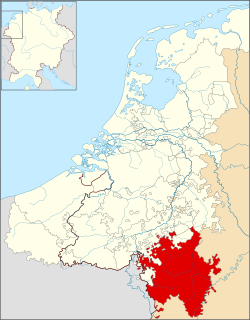
Back دوقية لوكسمبورغ Arabic Ducáu de Luxemburgu AST Dugelezh Luksembourg Breton Ducat de Luxemburg Catalan Lucemburské vévodství Czech Δουκάτο του Λουξεμβούργου Greek Duklando Luksemburgo Esperanto Ducado de Luxemburgo Spanish Luksemburgi hertsogkond Estonian Duché de Luxembourg French
Duchy of Luxembourg Herzogtum Lëtzebuerg (Luxembourgish) Herzogtum Luxemburg (German) Duché de Luxembourg (French) Hertogdom Luxemburg (Dutch) Ducatus Luxemburgensis (Latin) | |||||||||||||
|---|---|---|---|---|---|---|---|---|---|---|---|---|---|
| 1353–1443/1797 | |||||||||||||
 Luxembourg within the Low Countries, 1350 | |||||||||||||
| Status | State of the Holy Roman Empire Part of the Burgundian Netherlands (1443–1482) Part of the Habsburg Netherlands (1482–1581) Part of the Spanish Netherlands (1581–1714) Part of the Austrian Netherlands (1714–1795) | ||||||||||||
| Capital | Luxembourg | ||||||||||||
| Common languages | |||||||||||||
| Religion | Roman Catholicism | ||||||||||||
| Government | Feudal Duchy | ||||||||||||
| Duke of Luxemburg | |||||||||||||
• 1353–1383 | Wenceslaus I (first) | ||||||||||||
• 1415–1419 | Elizabeth of Görlitz | ||||||||||||
• 1419–1425 | John the Fearless | ||||||||||||
• 1425–1443 | Elizabeth of Gorlitz (last) | ||||||||||||
• 1439–1482 | William III of Saxony (claimant) | ||||||||||||
| Historical era | Middle Ages | ||||||||||||
• Obtained by Sigfried | 963 | ||||||||||||
• Acquired by Luxembourg dynasty | 1059 | ||||||||||||
• Raised to county | 1214 | ||||||||||||
• Raised to duchy by the Emperor | 1354 | ||||||||||||
• Held by the Dukes of Burgundy | 1443 | ||||||||||||
• To Habsburg | 1482 | ||||||||||||
• Occupied by France | 1797 | ||||||||||||
| ISO 3166 code | LU | ||||||||||||
| |||||||||||||
The Duchy of Luxembourg (Dutch: Luxemburg; French: Luxembourg; German: Luxemburg; Luxembourgish: Lëtzebuerg) was a state of the Holy Roman Empire, the ancestral homeland of the noble House of Luxembourg. The House of Luxembourg became one of the most important political forces in the 14th century, competing against the House of Habsburg for supremacy in Central Europe. They would be the heirs to the Přemyslid dynasty in the Kingdom of Bohemia, succeeding to the Kingdom of Hungary and contributing four Holy Roman Emperors until their own line of male heirs came to an end and the House of Habsburg received the territories that the two Houses had originally agreed upon in the Treaty of Brünn in 1364.
In 1443, the duchy passed to Duke Philip the Good of Burgundy of the French House of Valois, and, in 1477, by marriage to Archduke Maximilian I of Austria of the House of Habsburg. The Seventeen Provinces of the former Burgundian Netherlands were formed into an integral union by Charles V, Holy Roman Emperor in the Pragmatic Sanction of 1549. In 1795, French revolutionaries ended this situation.

